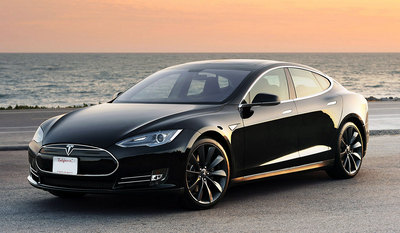Long-Range Electric Vehicles Set to Gain Popularity Globally
 2015 Tesla Model S P85D |
Europe likely to hold the second-highest market share by late 2015
LONDON -- April 21, 2015: The global electric vehicles market has made huge progress, with more than 55 models now available globally. Currently, over 70 percent of the models on the market are battery EVs (BEVs) and approximately 25 percent are plug-in hybrid EVs (PHEVs). Nevertheless, the number of PHEVs is likely to increase over the next three to four years. The market will see greater demand for longer-range vehicles that allow customers to drive up to and past the pure EV range. The BMW i3 sales split between BEV and extended range EVs (eREVs) demonstrates this trend.
New analysis from Frost & Sullivan, Strategic Outlook of Global Electric Vehicle Market in 2015 (Electric Vehicle Market), finds that EV sale volumes stood at 304,683 units in 2014 and estimates this to reach 466,407 units in 2015. At the end of the year, North America will continue to lead with a market share of 36 percent, followed by Europe and China with a share of 27 and 24 percent respectively. The study covers PHEVs, BEVs, neighbourhood EVs and eREVs.
For complimentary access to more information on this research, please visit: Access.
"Major EV original equipment manufacturers (OEMs) such as BMW, Tesla and Daimler expect to benefit from incentives and subsidies in China and have thus designed growth strategies to establish themselves firmly in the market," said Frost & Sullivan Automotive & Transportation Senior Research Analyst Prajyot Sathe. "However, with the annual decrease in incentives by five percent in China, some OEMs are looking at offering alternative technologies such as fuel cell vehicles to qualify for incentives."
Although the EV market is growing in all regions, overall sales have not met the expectations of automakers. Automakers in Europe and North America have not managed to achieve sales targets mainly due to end users' reluctance to adopt new technologies, the long charging time for vehicles, and the lack of awareness on the benefits of EVs.
While sales in the United States EV market have increased by 30 percent from its 2013 level, the number of PHEVs and EVs stand at approximately 162,000 – far from the one-million unit goal for 2015. As part of the strategy to expand sales, automakers are trying to double the energy density of Li-ion technology to improve EV range.
"To further boost sales, EV OEMs are focusing on improving accessibility by establishing EV charging networks through partnerships," noted Sathe. "Tesla, however, is building its proprietary super charging network and has over 120 stations in the US, 75 in Europe and 25 in Asia, where installations are anticipated to double by the end of this year."
EV infrastructure business models is just one of the current trends in the automotive and mobility space, which will be discussed during Frost & Sullivan's annual industry event "Intelligent Mobility: Future Business Models in Connected and Automated Mobility", taking place at the House of Lords and the Royal Garden Hotel in London on 1st and 2nd July 2015.


